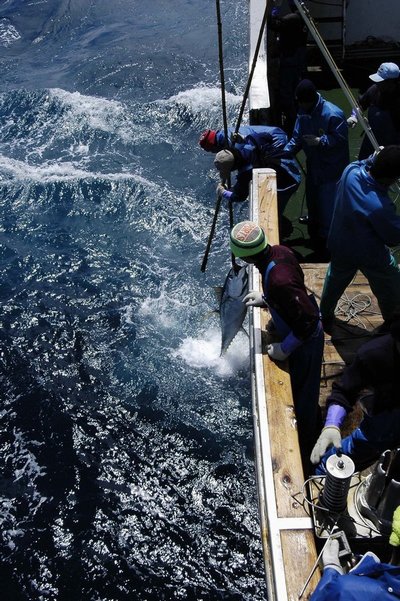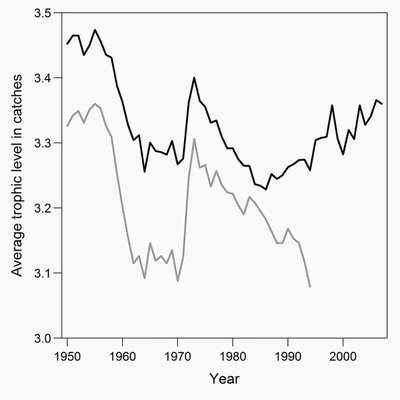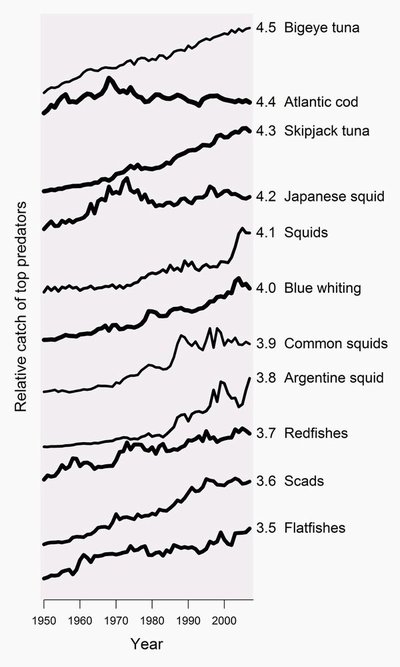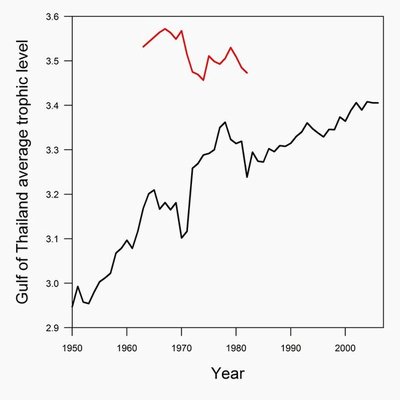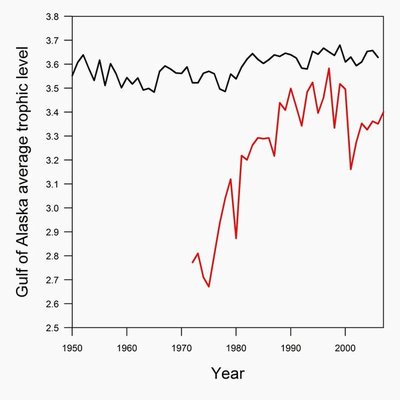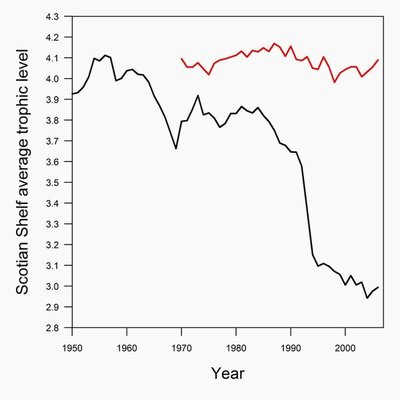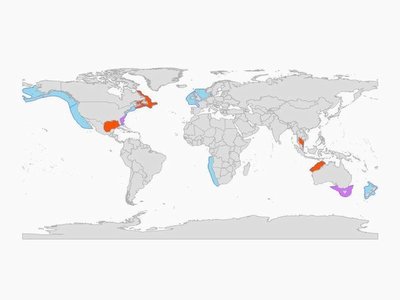November 17, 2010
Scientists question widely adopted indicator of fisheries health and evidence for ‘fishing down marine food webs’
The most widely adopted measure for assessing the state of the world’s oceans and fisheries led to inaccurate conclusions in nearly half the ecosystems where it was applied according to new analysis by an international team led by a University of Washington fisheries scientist.
“Applied to individual ecosystems it’s like flipping a coin, half the time you get the right answer and half the time you get the wrong answer,” said Trevor Branch, a UW assistant professor of aquatic and fishery sciences.
In 1998, the journal Science published a groundbreaking paper that was the first to use trends in the trophic levels of fish that were caught to measure the health of world fisheries. The trophic level of an organism shows where it fits in food webs, with microscopic algae at a trophic level of one and large predators such as sharks, halibut and tuna at a trophic level of around four.
The 1998 paper relied on four decades of catch data and averaged the trophic levels of what was caught. The authors determined those averages were declining over time and warned we were “fishing down the food web” by overharvesting fish at the highest trophic levels and then sequentially going after fish farther down the food web.
Twelve years later, newly compiled data has emerged that considers such things as the numbers and types of fish that actually live in these ecosystems, as well as catch data. An analysis in the Nov. 18, 2010, issue of Nature reveals weaknesses in assessing ecosystem health from changes in the trophic levels of what is being caught.
“This is important because that measure is the most widely adopted indicator by which to determine the overall health of marine ecosystems,” said Branch, lead author of the new analysis in Nature. Those involved with the U.N.’s Convention on Biological Diversity, for instance, chose to use the average trophic level of fish being caught as the main measure of global marine diversity.
An example of the problem with the measure is in the Gulf of Thailand, where the average trophic level of what is being caught is rising, which should indicate improving ecosystem health according to proponents of that measure. Instead, it turns out fish at all levels have declined tenfold since the 1950s because of overharvesting.
“The measure only declines if fisheries aimed for top predators first, but for the Gulf of Thailand the measure fails because fisheries first targeted mussels and shrimps near the bottom of the food web, before shifting to predators higher up in the food web,” Branch said.
Including the Gulf of Thailand, Branch found that changes in the average trophic levels of what was being caught and what was found when fish populations were surveyed differed in 13 of the 29 trawl surveys from 14 ecosystems. Trawl surveys, generally done from research vessels, count the kinds and abundance of fish and are repeated over time to reveal trends.
Branch and his co-authors are the first to combine so many trawl surveys for analysis — no one had combined more than a handful before. The trawl survey data came from efforts started three years ago by fisheries scientists and ecologists gathered at the National Center for Ecological Analysis and Synthesis http://www.nceas.ucsb.edu in Santa Barbara, Calif. They brought together worldwide catch data, stock assessments, scientific trawl surveys, small-scale fishery data and modeling results. What emerged is the most comprehensive set of data yet for fisheries researchers and managers.
It paints a different picture from previous catch data and has revealed another major new finding: On a global scale humans don’t appear to be fishing down the food web, Branch said.
The new catch data reveal that, following declines during the 1970s in the average trophic levels of fish being caught, catches of fish at all trophic levels have generally gone up since the mid-80s. Included are high-trophic predators such as bigeye tuna, skipjack tuna and blue whiting.
“Globally we’re catching more of just about everything,” Branch said. “Therefore relying on changes in the average trophic level of fish being caught won’t tell us when fishing is sustainable or if it is leading to collapse.” That’s because when harvests of everything increase about equally, the average trophic level of what is caught remains steady. The same is true if everything is overfished to collapse. Both scenarios were modeled as part of the Nature analysis.
“The 1998 paper was tremendously influential in gathering together global data on catches and trophic levels and it warned about fishing impacts on ecosystems,” Branch says. “Our new data from trawl surveys and fisheries assessments now tell us that catches weren’t enough. In the future we will need to focus our limited resources on tracking trends in species that are especially vulnerable to fishing and developing indicators that reflect fish abundance, biodiversity and marine ecosystem health. Only through such efforts can we reliably assess human impacts on marine ecosystems.”
“In this paper we conducted the first large-scale test of whether changes in the average trophic levels of what is caught are a good indicator of ecosystem status,” says Beth Fulton, a co-author and ecosystem modeler with the Commonwealth Scientific and Industrial Research Organisation, Australia. “Catch data might be easiest to get, but that doesn’t help if what it tells us is wrong. Instead we really need to look directly at what the ecosystems are doing.”
Other co-authors are Reg Watson and Grace Pablico, University of British Columbia; Simon Jennings, Centre for Environment, Fisheries and Aquaculture Science and University of East Anglia, England; Carey McGilliard, University of Washington; Daniel Ricard, Dalhousie University in Halifax, Nova Scotia; and Sean Tracey, University of Tasmania, Australia.
The work was supported by the National Science Foundation, Gordon and Betty Moore Foundation and the UW School of Aquatic and Fishery Sciences. It used data from the National Center for Ecological Analysis and Synthesis working group, used the stock assessment database funded by the Canadian Natural Sciences and Engineering Research Council and the Canadian Foundation for Innovation and used data from the Sea Around Us project funded by Pew Charitable Trust.
###
For more information:
Trevor Branch, 1-206-221-0776, tbranch@uw.edu
French-speaking reporters are invited to contact: Daniel Ricard, 1-902-494-3910, ricardd@mathstat.dal.ca
Reporters in Australia are invited to contact: Beth Fulton, 61-3-62325018 or 61-4-28564183, beth.fulton@csiro.au; and Sean Tracey, 61-3-62277286 or 61-4-38012786, sean.tracey@utas.edu.au
Additional figures and photographs available
http://tinyurl.com/fisheries-UWimages
Sources willing to comment, who are not co-authors:
“Monitoring all the fish in the sea would be an enormous, and impossible, task. But this study makes clear that the most common indicator, average catch trophic level, is a woefully inadequate measure of the status of marine fisheries.”
— Henry Gholz, program director
National Science Foundation’s Division of Environmental Biology
Contact through Cheryl Dybas, public information officer, 703-292-7734, cdybas@nsf.gov
“The research shows the importance of synthesis to furthering an understanding of fisheries impacts and management strategies. For complex ecosystem interactions, answers can only come from repeated scrutiny of data, and comparisons of different scientific methods and systems. This synthesis points to a path forward to evaluate fisheries influences on ocean ecosystems.”
— Phillip Taylor, section head
National Science Foundation’s Division of Ocean Sciences
Contact through Cheryl Dybas, public information officer, 703-292-7734, cdybas@nsf.gov
“Refining scientific concepts is a process of iterative testing. This group accelerated the call-and-response dialog that normally occurs among scientists, by doing what we do here at NCEAS – assembling experts with different perspectives under the same roof, with all the data they can find, and using some really sharp analytical tools to challenge important concepts.”
— Stephanie Hampton, deputy director
National Center for Ecological Analysis & Synthesis, University of California, Santa Barbara
805-892-2505, hampton@nceas.ucsb.edu
Websites:
The analysis being published in Nature was based on:
— Data compiled two years ago by a group led by Dalhousie University’s Boris Worm (http://wormlab.biology.dal.ca/) and University of Washington’s Ray Hilborn (http://www.fish.washington.edu/people/rayh/), conducted through the National Center for Ecological Analysis & Synthesis, http://www.nceas.ucsb.edu
— Science paper about that effort, “Rebuilding Global Fisheries,” July 31, 2009, http://www.sciencemag.org/cgi/content/abstract/325/5940/578
Fishing down marine food webs
— In 1998 Science published, “Fishing Down Marine Food Webs,” Feb. 6, 1998 http://www.sciencemag.org/cgi/content/abstract/279/5352/860
— Wikipedia: http://en.wikipedia.org/wiki/Peak_fish
Trevor Branch faculty website: http://www.fish.washington.edu/people/branch/
Other research led by UW in recent years concerning marine food webs:
— People who fish for a living pursue top profits, not necessarily top predators, Proceedings of the National Academy of Sciences, June 24, 2010, http://www.pnas.org/content/107/27/12163.abstract?sid=7cdaef2c-1957-49c4-9ad357141838ab20
— News release: http://uwnews.org/article.asp?articleid=58896
Fishing through marine food webs
— Proceedings of the National Academy of Sciences, Feb. 14, 2006, http://www.pnas.org/content/103/9/3171.abstract
— News release: http://uwnews.org/article.asp?article
